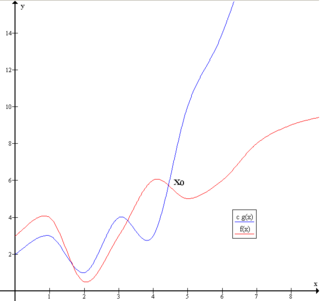
In mathematics, convolution is a mathematical operation on two functions that produces a third function that expresses how the shape of one is modified by the other. The term convolution refers to both the result function and to the process of computing it. It is defined as the integral of the product of the two functions after one is reversed and shifted. The integral is evaluated for all values of shift, producing the convolution function.

Big O notation is a mathematical notation that describes the limiting behavior of a function when the argument tends towards a particular value or infinity. Big O is a member of a family of notations invented by Paul Bachmann, Edmund Landau, and others, collectively called Bachmann–Landau notation or asymptotic notation.

In mathematics, a Fourier transform (FT) is a mathematical transform that decomposes functions depending on space or time into functions depending on spatial or temporal frequency, such as the expression of a musical chord in terms of the volumes and frequencies of its constituent notes. The term Fourier transform refers to both the frequency domain representation and the mathematical operation that associates the frequency domain representation to a function of space or time.

In thermodynamics, the Gibbs free energy is a thermodynamic potential that can be used to calculate the maximum reversible work that may be performed by a thermodynamic system at a constant temperature and pressure. The Gibbs free energy (, measured in joules in SI) is the maximum amount of non-expansion work that can be extracted from a thermodynamically closed system. This maximum can be attained only in a completely reversible process. When a system transforms reversibly from an initial state to a final state, the decrease in Gibbs free energy equals the work done by the system to its surroundings, minus the work of the pressure forces.

Schreckensteinioidea is a superfamily in the insect order Lepidoptera containing a single family, Schreckensteiniidae, or "bristle-legged moths", because of the stout spines on the hindlegs. The superfamily and family were both described by Thomas Bainbrigge Fletcher in 1929. The relationships of this family within the group apoditrysia are currently uncertain. One of the species, the blackberry skeletoniser, is widespread and common across Europe and has been introduced as a biological control to Hawaii, whilst three species of Corsocasis occur in South East Asia.

GOOD Music is an American record label founded by rapper Kanye West in 2004. The label signed an exclusive long-term worldwide label agreement with The Island Def Jam Music Group in 2011. In 2012, the label released its debut compilation album Cruel Summer. In 2015, Pusha T was appointed the president of the label by West, while record executive Steven Victor was appointed COO.

In telecommunications, 5G is the fifth generation technology standard for broadband cellular networks, which cellular phone companies began deploying worldwide in 2019, and is the planned successor to the 4G networks which provide connectivity to most current cellphones. 5G networks are predicted to have more than 1.7 billion subscribers worldwide by 2025, according to the GSM Association. Like its predecessors, 5G networks are cellular networks, in which the service area is divided into small geographical areas called cells. All 5G wireless devices in a cell are connected to the Internet and telephone network by radio waves through a local antenna in the cell. The main advantage of the new networks is that they will have greater bandwidth, giving higher download speeds, eventually up to 10 gigabits per second (Gbit/s). Due to the increased bandwidth, it is expected the networks will increasingly be used as general internet service providers for laptops and desktop computers, competing with existing ISPs such as cable internet, and also will make possible new applications in internet-of-things (IoT) and machine-to-machine areas. 4G cellphones are not able to use the new networks, which require 5G-enabled wireless devices.
Frank Oppong is a Ghanaian middleweight boxer from Accra, Ghana who now lives in Luton, London. England. Oppong was introduced to boxing by N.N. Heward Mills. He currently works as a businessman in Chiswick.
Myrtartona is a genus of moths of the family Zygaenidae.
Myrtartona coronias is a species of moth in the family Zygaenidae. It is found in eastern and south-eastern Australia, from southern Queensland to Tasmania.

The MV Regal Lady is a 1930 built steel passenger boat moored at the port of Scarborough, North Yorkshire. She is a National Historic Ship, owned and preserved by Scarborough Pleasure Steamers. The ship participated in Operation Dynamo at Dunkirk, was decommissioned in 1946, and in 1954 was moved to Scarborough and renamed from Oulton Belle to its current name.

Corsocasis is a genus of moths in the family Schreckensteiniidae. The species of this genus are found in South-East Asia.

Turridae is a taxonomic family name for a number of predatory sea snails, marine gastropod mollusks in the superfamily Conoidea.
Corsocasis cryptosema is a moth in the family Schreckensteiniidae. It was described by Edward Meyrick in 1929.










